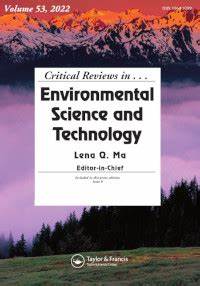Recent advances in layered double hydroxides for pharmaceutical wastewater treatment: A critical review
IF 13.2
1区 环境科学与生态学
Q1 ENVIRONMENTAL SCIENCES
Critical Reviews in Environmental Science and Technology
Pub Date : 2025-07-18
DOI:10.1080/10643389.2025.2488808
引用次数: 0
Abstract
In recent decades, pharmaceuticals, lauded for saving millions of lives, have surfaced as a new class of environmental contaminants. These compounds, originating primarily from hospital and industrial settings, often resist traditional treatment technologies and can persist in the environment for extended periods. The scarcity of water resources underscores the urgent need for innovative strategies for the effective management of pharmaceutical wastewater. Recently, layered double hydroxides (LDHs) have garnered considerable attention for their application in the remediation of pharmaceutical wastewater. This review explores the recent advancements in LDH-based adsorbents and membranes for pharmaceutical wastewater treatment. LDHs demonstrate superior adsorption capabilities due to their intercalation properties and structural versatility, effectively removing pharmaceutical contaminants such as antibiotics and anti-inflammatory drugs. Moreover, LDH-modified membranes enhance separation efficiency by improving permeability, selectivity, and fouling resistance. Advanced analytical techniques, including machine learning and synchrotron radiation, have provided deeper insights into the LDH mechanisms. However, challenges such as metal leaching, low mechanical durability, and limited scalability remain critical hurdles. Future research should focus on optimizing LDH stability, integrating adsorption with membrane separation techniques, and exploring hybrid treatment strategies. The recovery of valuable pharmaceuticals through LDH-based systems also presents a sustainable approach to wastewater management. This review highlights the potential of LDHs in pharmaceutical wastewater treatment while identifying key points for further development to enhance their practicality and large-scale application.层状双氢氧化物在制药废水处理中的最新进展
近几十年来,因拯救了数百万人的生命而备受赞誉的药品,已成为一类新的环境污染物。这些化合物主要来自医院和工业环境,往往抵抗传统的治疗技术,并可在环境中长期存在。水资源的稀缺强调了迫切需要创新战略来有效管理制药废水。近年来,层状双氢氧化物(LDHs)在制药废水修复中的应用受到了广泛的关注。本文综述了ldh基吸附剂和膜用于制药废水处理的最新进展。由于其插层特性和结构的通用性,LDHs具有优越的吸附能力,可以有效地去除抗生素和抗炎药物等药物污染物。此外,ldh改性膜通过提高渗透性、选择性和抗污性来提高分离效率。先进的分析技术,包括机器学习和同步辐射,为LDH机制提供了更深入的见解。然而,诸如金属浸出、低机械耐久性和有限的可扩展性等挑战仍然是关键障碍。未来的研究应着眼于优化LDH的稳定性,将吸附与膜分离技术相结合,探索混合处理策略。通过基于ldh的系统回收有价值的药物也为废水管理提供了一种可持续的方法。本文综述了LDHs在制药废水处理中的潜力,并指出了进一步发展的重点,以提高其实用性和大规模应用。
本文章由计算机程序翻译,如有差异,请以英文原文为准。
求助全文
约1分钟内获得全文
求助全文
来源期刊
CiteScore
27.30
自引率
1.60%
发文量
64
审稿时长
2 months
期刊介绍:
Two of the most pressing global challenges of our era involve understanding and addressing the multitude of environmental problems we face. In order to tackle them effectively, it is essential to devise logical strategies and methods for their control. Critical Reviews in Environmental Science and Technology serves as a valuable international platform for the comprehensive assessment of current knowledge across a wide range of environmental science topics.
Environmental science is a field that encompasses the intricate and fluid interactions between various scientific disciplines. These include earth and agricultural sciences, chemistry, biology, medicine, and engineering. Furthermore, new disciplines such as environmental toxicology and risk assessment have emerged in response to the increasing complexity of environmental challenges.
The purpose of Critical Reviews in Environmental Science and Technology is to provide a space for critical analysis and evaluation of existing knowledge in environmental science. By doing so, it encourages the advancement of our understanding and the development of effective solutions. This journal plays a crucial role in fostering international cooperation and collaboration in addressing the pressing environmental issues of our time.

 求助内容:
求助内容: 应助结果提醒方式:
应助结果提醒方式:


